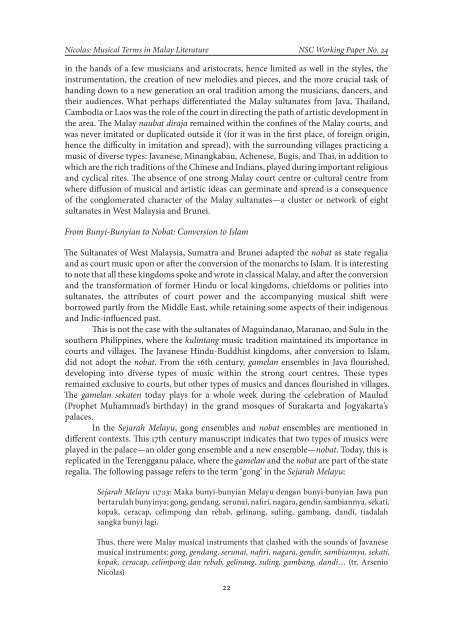2k2ADzp
2k2ADzp
2k2ADzp
You also want an ePaper? Increase the reach of your titles
YUMPU automatically turns print PDFs into web optimized ePapers that Google loves.
Nicolas: Musical Terms in Malay Literature NSC Working Paper No. 24<br />
in the hands of a few musicians and aristocrats, hence limited as well in the styles, the<br />
instrumentation, the creation of new melodies and pieces, and the more crucial task of<br />
handing down to a new generation an oral tradition among the musicians, dancers, and<br />
their audiences. What perhaps differentiated the Malay sultanates from Java, Thailand,<br />
Cambodia or Laos was the role of the court in directing the path of artistic development in<br />
the area. The Malay naubat diraja remained within the confines of the Malay courts, and<br />
was never imitated or duplicated outside it (for it was in the first place, of foreign origin,<br />
hence the difficulty in imitation and spread), with the surrounding villages practicing a<br />
music of diverse types: Javanese, Minangkabau, Achenese, Bugis, and Thai, in addition to<br />
which are the rich traditions of the Chinese and Indians, played during important religious<br />
and cyclical rites. The absence of one strong Malay court centre or cultural centre from<br />
where diffusion of musical and artistic ideas can germinate and spread is a consequence<br />
of the conglomerated character of the Malay sultanates—a cluster or network of eight<br />
sultanates in West Malaysia and Brunei.<br />
From Bunyi-Bunyian to Nobat: Conversion to Islam<br />
The Sultanates of West Malaysia, Sumatra and Brunei adapted the nobat as state regalia<br />
and as court music upon or ater the conversion of the monarchs to Islam. It is interesting<br />
to note that all these kingdoms spoke and wrote in classical Malay, and ater the conversion<br />
and the transformation of former Hindu or local kingdoms, chiefdoms or polities into<br />
sultanates, the attributes of court power and the accompanying musical shit were<br />
borrowed partly from the Middle East, while retaining some aspects of their indigenous<br />
and Indic-influenced past.<br />
This is not the case with the sultanates of Maguindanao, Maranao, and Sulu in the<br />
southern Philippines, where the kulintang music tradition maintained its importance in<br />
courts and villages. The Javanese Hindu-Buddhist kingdoms, ater conversion to Islam,<br />
did not adopt the nobat. From the 16th century, gamelan ensembles in Java flourished,<br />
developing into diverse types of music within the strong court centres. These types<br />
remained exclusive to courts, but other types of musics and dances flourished in villages.<br />
The gamelan sekaten today plays for a whole week during the celebration of Maulud<br />
(Prophet Muhammad’s birthday) in the grand mosques of Surakarta and Jogyakarta’s<br />
palaces.<br />
In the Sejarah Melayu, gong ensembles and nobat ensembles are mentioned in<br />
different contexts. This 17th century manuscript indicates that two types of musics were<br />
played in the palace—an older gong ensemble and a new ensemble—nobat. Today, this is<br />
replicated in the Terengganu palace, where the gamelan and the nobat are part of the state<br />
regalia. The following passage refers to the term ‘gong’ in the Sejarah Melayu:<br />
Sejarah Melayu 117:13: Maka bunyi-bunyian Melayu dengan bunyi-bunyian Jawa pun<br />
bertarulah bunyinya; gong, gendang, serunai, nafiri, nagara, gendir, sambiannya, sekati,<br />
kopak, ceracap, celimpong dan rebab, gelinang, suling, gambang, dandi, tiadalah<br />
sangka bunyi lagi.<br />
Thus, there were Malay musical instruments that clashed with the sounds of Javanese<br />
musical instruments: gong, gendang, serunai, nafiri, nagara, gendir, sambiannya, sekati,<br />
kopak, ceracap, celimpong dan rebab, gelinang, suling, gambang, dandi… (tr. Arsenio<br />
Nicolas)<br />
22


